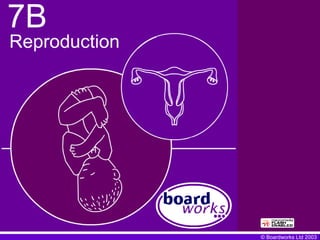
Human Reproduction Document
- 1. © Boardworks Ltd 2003
- 2. © Boardworks Ltd 2003 A slide contains teacher’s notes wherever this icon is displayed - To access these notes go to ‘Notes Page View’ (PowerPoint 97) or ‘Normal View’ (PowerPoint 2000). Normal ViewNotes Page View Teacher’s Notes Flash Files A flash file has been embedded into the PowerPoint slide wherever this icon is displayed – These files are not editable.
- 3. © Boardworks Ltd 2003 Human Reproduction Humans use sexual reproduction to produce their young. In order to do this the two parents have to have sex organs so that they can produce sex cells. In humans, males and females have different reproductive systems and sex organs Go to the activity on the next page to see how much you know.
- 4. © Boardworks Ltd 2003 The next slide shows the names of eight different parts of the male and female human reproductive systems. Drag a name to the correct column depending on whether you think that this is part of the male system or part of the female system. Male or Female
- 5. © Boardworks Ltd 2003 Male or Female
- 6. © Boardworks Ltd 2003 The Male Reproductive System
- 7. © Boardworks Ltd 2003 The Female Reproductive System
- 8. © Boardworks Ltd 2003 Reproductive System
- 9. © Boardworks Ltd 2003 Sex cells - Sperm In males the sex cells are called sperm. Sperm are produced in sex organs called testes.
- 10. © Boardworks Ltd 2003 Sex cells - Eggs In females the sex cells are called eggs. Eggs are produced in sex organs called ovaries. Nucleus containing chromosomes cytoplasm membrane jelly coat An egg is so big that this is how big a sperm looks next to it.
- 11. © Boardworks Ltd 2003 Sperm or Egg? Both sperm and eggs have special features that makes it possible for them to carry out their jobs. Look at the statements on the next page and decide which one you think belongs to an egg and which one belongs to a sperm. Once you think you know push the buttons to see if you are right.
- 12. © Boardworks Ltd 2003 Sperm or Egg?
- 13. © Boardworks Ltd 2003 Ovulation and Fertilisation In the female one of the ovaries produces an egg every 28 days. This is called ovulation. During sexual intercourse sperm is ejaculated into the vagina. If the sperm and egg meet the sperms nucleus will join with the eggs nucleus. This is called fertilisation.
- 14. © Boardworks Ltd 2003 Fertilisation and Implantation
- 15. © Boardworks Ltd 2003 Word Check
- 16. © Boardworks Ltd 2003 The Placenta It forms a plate-like structure called the placenta. The umbilical cord joins the fetus to the placenta. In the placenta food and oxygen diffuse from the mothers blood into the blood of the fetus. Carbon dioxide and waste products diffuse from the blood of the fetus to the mothers blood. How does the embryo get food and oxygen and how does it get rid of waste?
- 17. © Boardworks Ltd 2003 The Placenta
- 18. © Boardworks Ltd 2003 The Embryo
- 19. © Boardworks Ltd 2003 Embryo Development
- 20. © Boardworks Ltd 2003 Embryo Development In one of these images the developing baby is called an embryo. Which one is it? What name is given to the other five developing babies?
- 21. © Boardworks Ltd 2003 Birth
- 22. © Boardworks Ltd 2003 Puberty Human children are born with a complete set of sex organs. However they do not become active until later in life. Between 10 and 18 the testes start to make sperm and the ovaries start to make eggs. This time of development in their life is called PUBERTY. As well as these changes other changes may also occur.
- 23. © Boardworks Ltd 2003 Puberty in Girls
- 24. © Boardworks Ltd 2003 Puberty in Boys
- 25. © Boardworks Ltd 2003 One change that happens to girls at puberty is that they start to undergo a monthly cycle called the menstrual cycle. This cycle is a process where the uterus lining builds up to receive a fertilised egg. If an egg is not fertilised then the lining of the uterus breaks down and is lost from the body. This is called menstruation or a period. Menstruation
- 26. © Boardworks Ltd 2003 The Menstrual Cycle
Editor's Notes
- A drag and drop activity
- The labels will reveal the function of the body part when the mouse is clicked over the labels and held down.
- The labels will reveal the function of the body part when the mouse is clicked over the labels and held down.
- A drag and drop activity
- The sperm and it’s labels are flash animations
- The buttons on this screen will reveal the word sperm or egg when the mouse button is put over them and held.
- A drag and drop activity
- The embryo (fetus after 9 weeks) develops in membranous bag and is cushioned by amniotic fluid.
- A drag and drop activity
- A drag and drop activity
- A drag and drop activity